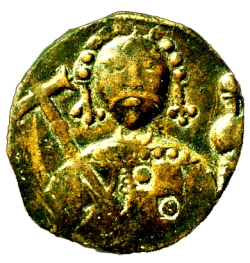
Robert "Guiscard" de Hauteville, sometimes Robert "the Guiscard", also nicknamed “Terror Mundi”, was a Norman adventurer remembered for his conquest of southern Italy and Sicily in the 11th century.

Roger I, nicknamed Roger Bosso and The Great Count, was a Norman nobleman who became the first Count of Sicily from 1071 to 1101. He was a member of the House of Hauteville, and his descendants in the male line continued to rule Sicily down to 1194.

Tancred of Hauteville was an 11th-century Norman petty lord about whom little is known. He was a minor noble near Coutances in the Cotentin. Tancred is primarily known by the achievements of his twelve sons.

Drogo of Hauteville was the second Count of Apulia and Calabria (1046–51) in southern Italy. Initially he was only the leader of those Normans in the service of Prince Guaimar IV of Salerno, but after 1047 he was a territorial prince owing fealty directly to the Emperor.

Humphrey of Hauteville, surnamed Abagelard, was the count of Apulia and Calabria from 1051 to his death.
Serlo I of Hauteville was a son of Tancred of Hauteville by his first wife, Muriella, probably the youngest, though some sources call him the eldest. Born before 1010, he was the eldest son of Tancred's to remain in Normandy. After a dispute with a neighbour, whom he killed over an insult, Serlo was exiled for three years. Around 1041, his father died and he inherited the small fief of Hauteville in the Cotentin and the sirery of Pirou through his wife. He was regarded, as were his brothers, as an exceptional warrior.
Richard Drengot was the count of Aversa (1049–1078), prince of Capua and duke of Gaeta (1064–1078).
Jordan of Hauteville was the eldest son and bastard of Roger I of Sicily. A fighter, he took part, from an early age, in the conquests of his father in Sicily.
Geoffrey of Hauteville was a Norman military leader, the second youngest son of Tancred of Hauteville by his first wife Muriella. He joined his brothers in the Mezzogiorno around 1053, arriving with his half-brothers Mauger and William. He was certainly present at the Battle of Civitate in that year.
William of Hauteville was one of the younger sons of Tancred of Hauteville by his second wife Fressenda. He is usually called Willermus instead of Wilelmus in Latin annals and so is often called Guillerm instead of Guillaume in French.
Peter I, also known as Petronius, was the first Norman count of Trani. He was one of the most prominent of the twelve leaders of the Norman mercenaries serving Guaimar IV of Salerno. Though it had not yet been conquered from the Byzantine Empire, Peter received Trani in the Normans' division of Apulia made at Melfi in 1042. In that same division his brother Walter received Civitate.
Geoffrey the Elder was an Italo-Norman nobleman. A nephew of Robert Guiscard through one of his sisters, he was the count of Conversano from 1072 and the lord of Brindisi and Nardò from 1070, until his death.

The Hauteville was a Norman family originally of seigneurial rank from the Cotentin. The Hautevilles rose to prominence through their part in the Norman conquest of southern Italy. By 1130, one of their members, Roger II, was made the first King of Sicily. His male-line descendants ruled Sicily until 1194. Some Italian Hautevilles took part in the First Crusade and the founding of the Principality of Antioch (1098).
The Drengots were a Norman family of mercenaries, one of the first to head to Southern Italy to fight in the service of the Lombards. They became the most prominent family after the Hautevilles.
Loritello was an Italo-Norman county along the Adriatic north of the Gargano, now called Rotello, in the Molise region. It was carved out of the eastern seaboard of the Principality of Benevento following the Battle of Civitate in 1053 by members of the Hauteville family. The last Count of Loritello died in 1184 and the title was never revived.

The Norman conquest of southern Italy lasted from 999 to 1139, involving many battles and independent conquerors.

The County of Apulia and Calabria, later the Duchy of Apulia and Calabria, was a Norman state founded by William of Hauteville in 1042 in the territories of Gargano, Capitanata, Apulia, Vulture, and most of Campania. It became a duchy when Robert Guiscard was raised to the rank of duke by Pope Nicholas II in 1059.

The Battle of Cerami was fought in June 1063 and was one of the most significant battles in the Norman conquest of Sicily, 1060–1091. The battle was fought between a Norman expeditionary force and a Muslim alliance of Sicilian and Zirid troops. The Normans fought under the command of Roger de Hauteville, the youngest son of Tancred of Hauteville and brother of Robert Guiscard. The Muslim alliance consisted of the native Sicilian Muslims under the Kalbid ruling class of Palermo, led by Ibn al-Hawas, and Zirid reinforcements from North Africa led by the two princes, Ayyub and 'Ali. The battle was a resounding Norman victory that utterly routed the opposing force, causing divisions amongst the Muslim aristocracy which ultimately paved the way for the eventual capture of the Sicilian capital, Palermo, by the Normans and subsequently the rest of the island.
Joscelin was a Norman count of Molfetta on the Adriatic coast of southern Italy. He rejected the leadership of Duke Robert Guiscard and rebelled, perhaps as early as 1064, certainly by 1067. Defeated, he went over the Byzantines in 1068.